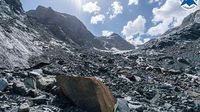Italy’s Ventina glacier, nestled in the rugged beauty of northern Lombardy, has long been a sentinel of the Alps’ icy majesty. For over 130 years, geologists trekked across its shimmering surface, driving stakes into the ice to measure its slow retreat. This year, however, marks a somber turning point: the glacier has melted and crumbled so dramatically due to climate change that those age-old methods are now impossible. The stakes, once reliable benchmarks, have vanished beneath rockslides and debris, and the terrain has become too unstable for anyone to safely set foot on it.
The news, reported by ABC and corroborated by multiple international outlets, underscores the accelerating crisis facing Europe’s glaciers. After another blisteringly hot summer in 2025, the Lombardy Glaciological Service announced that it can no longer monitor the Ventina glacier in person. Instead, the team will now rely on drone imagery and remote sensing technology to track the glacier’s ongoing shrinkage. It’s a stark shift for researchers who have, until now, depended on hands-on measurements to understand the glacier’s health and behavior.
“While we could still hope until the 1980s that there would be normal cycles (of retraction) or at least a contained retraction, in the last 40 years something truly striking has occurred,” said Andrea Toffaletti, a member of the Lombardy Glaciological Service, in a statement cited by ABC. His words echo a growing sense of alarm among scientists who have watched the glacier’s retreat accelerate in recent years.
The numbers tell a grim story. According to the Lombardy Glaciological Service, the Ventina glacier has lost 431 meters in length over the past decade. Nearly half of that loss—an astonishing 200 meters—has occurred since 2021 alone. Where once there was steady, predictable melting each summer, now there is a rapid, almost frantic retreat. The glacier’s surface is increasingly covered not by pristine snow, but by unstable rock and debris. This has made the area so hazardous that future in-person visits are out of the question.
The Ventina glacier’s plight is not unique. Italy’s mountain glaciers, found throughout the Alps and Dolomites in the north and even along the central Apennines, have been receding for years. The primary culprits, experts say, are inadequate snowfall during the winter and record-setting hot summers—a deadly combination that leaves glaciers unable to replenish themselves. “Hot summers are no longer able to guarantee the survival of the winter snowpack, which keeps the glacier intact,” Toffaletti explained. “In order to regenerate and remain in balance, a certain amount of residual snow from the winter must remain on the glacier's surface at the end of the summer. And this is happening less and less frequently.”
It’s a vicious cycle. Glaciers naturally melt a bit every summer, feeding mountain streams and rivers with their runoff. But as summers become hotter and winters bring less snow, the glaciers lose more ice than they gain. The Alps, in particular, have become a climate hotspot, the Lombardy Glaciological Service reports. Since pre-industrial times, the region has experienced temperature increases at double the global average. The result? More than 64 percent of the volume of Alpine glaciers has vanished, a staggering loss that has profound implications for the environment, local communities, and even sporting events.
The Ventina glacier sits near Sondrio in northeast Lombardy, not far from the site of some 2026 Winter Olympics events. The irony is hard to miss: while the world’s athletes prepare to compete on snow and ice, the very glaciers that symbolize winter’s endurance are fading away. Organizers and local officials are watching the situation closely, aware that the loss of these glaciers could affect everything from water supplies to tourism and recreation.
The crisis is not confined to the Alps. A study published in February 2025 in the journal Nature found that the world’s glaciers lost ice at the rate of about 231 billion tonnes annually from 2000 to 2011. That already alarming rate quickened to approximately 314 billion tonnes annually over the following decade. The accelerating melt is a global phenomenon, but its effects are felt acutely in regions like Lombardy, where glaciers are both a natural wonder and a vital resource.
For the scientists who have dedicated their careers to studying the Ventina glacier, the transition to remote monitoring is bittersweet. Drone imagery and satellite data can provide a bird’s-eye view of the glacier’s changes, but they can’t replace the physical connection that comes from standing on the ice itself. “It’s another example of how accelerating global warming is melting and shrinking Europe’s glaciers, causing a host of environmental and other impacts,” the Lombardy Glaciological Service noted in its announcement.
The environmental impacts of glacier loss are far-reaching. Glaciers act as natural reservoirs, storing water that is released gradually throughout the year. As they shrink, the flow of water to rivers and streams becomes less predictable, threatening agriculture, hydropower, and the delicate balance of mountain ecosystems. There’s also the risk of sudden floods caused by the collapse of unstable glacial dams, as well as the loss of unique habitats for alpine plants and animals.
Communities in Lombardy and across the Alps are already feeling the effects. Tourism, a major economic driver in the region, depends on the allure of snow-capped peaks and icy landscapes. As the glaciers retreat, some ski resorts have had to close early or invest in artificial snowmaking, a costly and energy-intensive solution. Others are pivoting toward summer tourism, promoting hiking and mountain biking instead of skiing. But even these activities are threatened by the unstable terrain left behind by melting glaciers and rockslides.
There’s a sense of urgency in the scientific community, but also a recognition that reversing the damage will not be easy. The loss of the Ventina glacier’s traditional measurement methods is both a practical problem and a powerful symbol of the challenges ahead. As Toffaletti and his colleagues adapt to new technologies, they hope their work will draw attention to the broader crisis facing Europe’s glaciers—and the need for decisive action to address climate change.
In the shadow of the shrinking Ventina glacier, the stakes—literal and figurative—have never been higher. As scientists turn to drones and satellites, the world watches, hoping that the lessons learned here will help preserve what remains of these icy giants for future generations.




